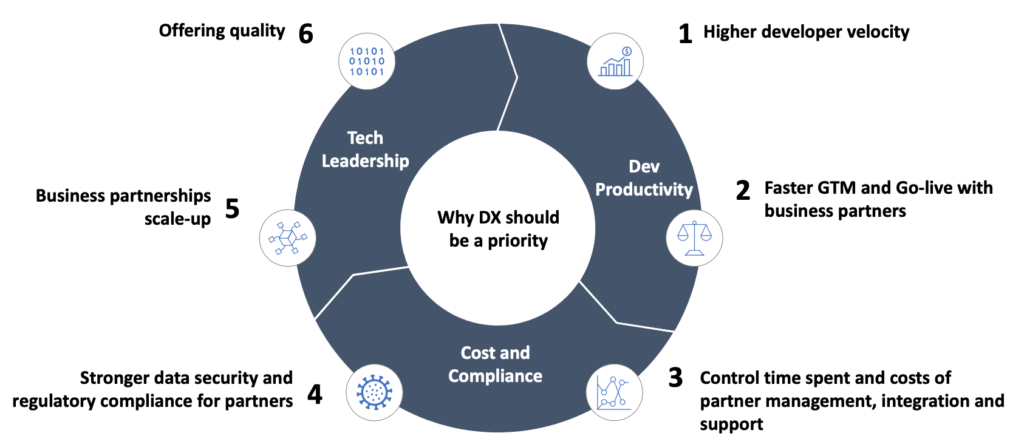Why You Should Prioritize Developer Experience

Uncovering the hidden costs of underinvesting in developer experience
Much like Customer Experience and Employee Experience, Developer Experience is important for similar reasons – developers who have a good experience are more satisfied, more loyal, more sticky, and promote more.
For companies with API-led offerings, bringing focus to Developer Experience can help unlock significant opportunity across developer productivity, cost and compliance, and technology leadership.
Why you should put Developer Experience at the centre of your efforts
Even companies which identify as “API-First” oftentimes underinvest in the offerings that aid successful, seamless adoption of the APIs – i.e. Developer Experience tools, and experience friction along the developer integration journeys – drop-offs, issues and escalations, long development cycles, significant support requirements, and generally dissatisfied integrating developers as well as employees assisting API adoption.
Focused efforts on solving for a distinctive developer experience drives not only higher developer opinion of your offerings, but also has an impact on productivity and performance, and on business metrics.
DX should not be limited to just external partners or public-facing APIs. According to Postman’s 2022 State of the API Report, ~58% of APIs are private APIs, and internal developers are crucial stakeholders for ensuring the success of your offerings.

1. Higher developer velocity: In a majority of companies, developers spend only 40-50% in activities directly contributing to coding (State of DevOps 2018, 2022) Developers are spending time on boilerplate activities. Furthermore, fragmentation of process and tooling, and poor discoverability of information and offerings are significant time sinks – all of which can be avoided with targeted investments in DX, and all of which directly translate into returns on the investment in DX.DX can be leveraged to break silos between developing teams (internal as well as partners), automating the path from on-boarding to go-live, providing clarity and transparency on offerings and process, and conduct timely checks on quality, security and compliance – helping developers cover ground faster, and shorten launch cycles – to days, instead of months.
2. Faster time to market: due emphasis on the developer journey – from on-boarding through to API integration and post-integration directly impacts developer velocity, and hence, time to launch. Fewer bottlenecks, more transparency, shorter discovery cycles – all help developers plan their time, and overall translate into shorter GTM and go-live timelines.
3. Productivity and cost savings: There is significant cost opportunity that companies can realize, when there are fewer support requests and issue resolutions to handle. Additionally, reducing inefficiencies via DX investment generates additional internal developer capacity without the need for hiring.Our research and experience also shows that improving DX leads to higher employee satisfaction – and more satisfied employees are 2x more likely to recommend their company as a great place to work at. This is especially significant in today’s tech environment with fierce competition for talent and increasing recruitment costs.
4. Security, regulatory and process compliance: When security and compliance are integrated into DX – for example, when security testing, regulatory and compliance checks are part of the CI/CD pipeline, this significantly reduces routine work and effort required in meeting the company’s security, risk and audit requirements. Furthermore, DX tools can help standardize terminology and practices across teams, which further reduces friction at the time of compliance or audits.
5. Scalability: rapid growth of API-led offerings has led to challenges – hampering partnership scalability. Large new partnerships at times require significant hand-holding – companies need to explain their API offerings, help the business partners craft their products, get on-boarded on the APIs and help them through the entire development and go-live process. This entails that companies need a large workforce that is dedicated to maintaining partnerships and helping with API integrations, making it harder to scale up business partnerships and API integrations. This problem has become acute – especially in financial services, where institutions are preferring to deliberately limit partnerships to a small number, to manage the integration and maintenance burden.DX designed to automate developer journeys, reduce process overheads and help developers navigate the system and process complexity can also help companies realize scaling up of business partnerships.
6. Offering quality: DX can help ensure a consistent, standard, high-quality experience for developers, which signals the overall technological leadership of your company, in a similar manner as well-designed UX is reflective of a strong product quality.
Not investing in DX has hidden costs!
Poor developer experience has direct repercussions on business performance.
1. You are spending more: lower developer and team productivity means that you’re spending on a larger team for a sub-optimal output, and incurring avoidable spends on support and service requests, issue resolution, boilerplate activity.
2. You are earning less: longer on-boarding timelines, longer lead times to development and go-live come with a built-in opportunity cost – the path to revenue is also longer.
3. You are growing slowly: restricted ability to drive multiple engagements / integrations in parallel impacts companies’ ability to adequately grasp all growth opportunities. Additionally, poor DX puts a ceiling on a company’s ability to scale significantly.
4. Your developers and employees are unhappy: a poor DX means that developers are spending less time on value-added work, and more time navigating systems and processes, discovering information and crossing technical and operational hurdles. This results in lower satisfaction, and a lower NPS for the offerings.


